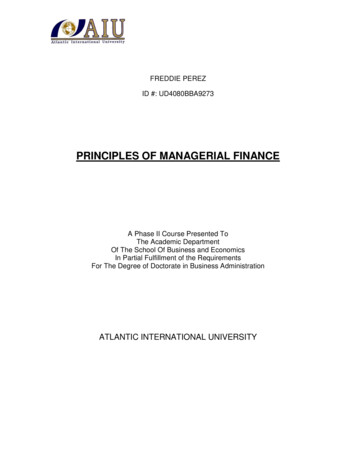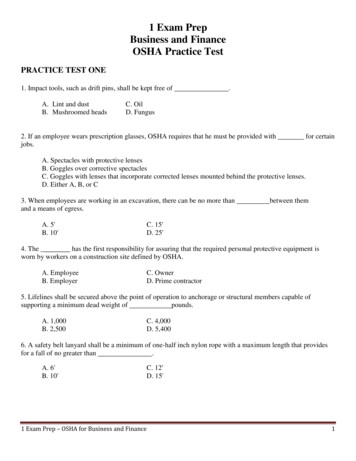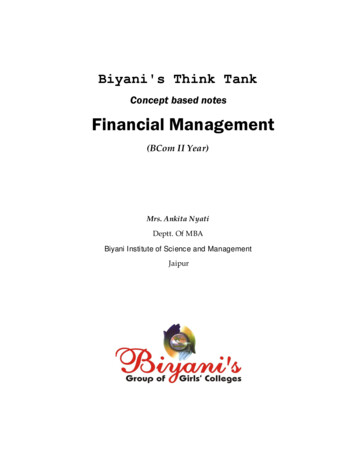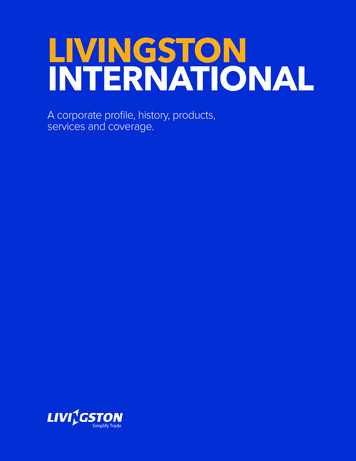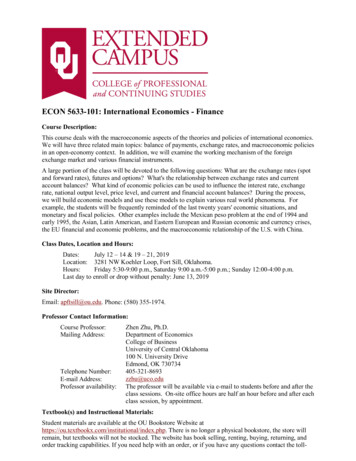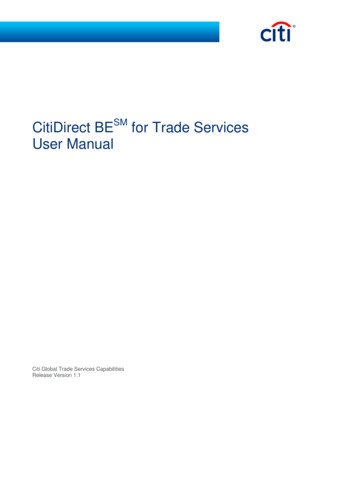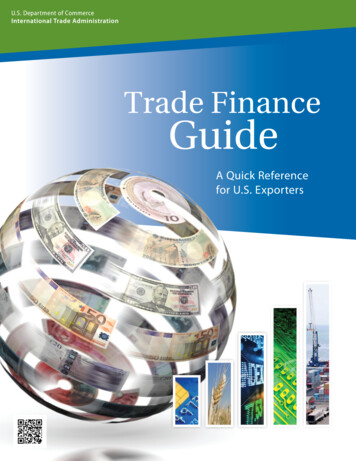
Transcription
Trade FinanceGuideA Quick Referencefor U.S. Exporters
Trade Finance Guide: A Quick Reference for U.S. Exporters is designed to help U.S. companies, especially small and medium-sizedenterprises, learn the basic fundamentals of trade finance so that they can turn their export opportunities into actual salesand to achieve the ultimate goal of getting paid—especially on time—for those sales. Concise, two-page chapters offer thebasics of numerous financing techniques, from open accounts, to forfaiting to government assisted foreign buyer financing.
TRADE FINANCE GUIDETable of ContentsIntroduction.1Chapter 1:Methods of Payment in International Trade.3Chapter 2:Cash-in-Advance.5Chapter 3:Letters of Credit.7Chapter 4:Documentary Collections.9Chapter 5:Open Account. 11Chapter 6:Consignment. 13Chapter 7:Export Working Capital Financing. 15Chapter 8:Government-Guaranteed Export Working Capital Loan Programs. 17Chapter 9:Export Credit Insurance. 19Chapter 10:Export Factoring. 21Chapter 11:Forfaiting. 23Chapter 12:Government-Assisted Foreign Buyer Financing. 25Chapter 13:Government-Backed Agricultural Export Financing. 27Chapter 14:Foreign Exchange Risk Management. 29Published November 2012The International Trade Administration’s mission is to create prosperity by strengthening the competitiveness of U.S. industry, promoting tradeand investment, and ensuring fair trade and compliance with trade laws and agreements. To learn more about the ITA write to: International TradeAdministration, Office of Public Affairs, U.S. Department of Commerce, Washington, DC 20230 or visit the ITA’s Web site at www.trade.gov.
TRADE FINANCE GUIDEIntroductionOpportunities, Risks, and Trade FinanceWelcome to the third edition of the Trade Finance Guide: A Quick Reference for U.S. Exporters.This guide is designed to help U.S. companies, especially small and medium-sized enterprises(SMEs), learn the basic fundamentals of trade finance so that they can turn their export opportunities into actual sales and to achieve the ultimate goal of getting paid—especially on time—for thosesales. This guide provides general information about common techniques of export financing. Accordingly,you are advised to assess each technique in light of your specific situation or needs. This edition includestwo new chapters on “Consignment” and “Government-Backed Agricultural Export Financing” with minorupdates on other chapters. The Trade Finance Guidewill be revised and updated as needed. Future editions may include new chapters discussing othertrade finance techniques and related topics.A QUICK GLANCEBenefits of ExportingThe United States is the world’s second largest exporter, with 2.06 trillion in goods and services exportsin 2011, according to the World Trade Organization’sWorld Trade Report 2012. In 2011, the United Stateswas the top exporter of services and second largest exporter of goods, behind only China. However,95 percent of the world’s consumers live outside ofthe United States. So if you are selling only domestically, you are reaching just a small share of potentialcustomers. Exporting enables SMEs to diversify theirportfolios and insulates them against periods ofslower growth in the domestic economy. Free tradeagreements (FTAs) have helped to open markets suchas Australia, Canada, Central America, Chile, Israel,Jordan, Korea, Mexico, and Singapore. FTAs createmore export opportunities for U.S. businesses. TheTrade Finance Guide is designed to provide U.S. SMEswith the knowledge necessary to grow and becomecompetitive in overseas markets.Trade Finance GuideA concise, simple, and easy-to-understand guidedesigned to help U.S. small and medium-sized exporterslearn quickly how to get paid from their foreign customersin the most effective manner.Trade FinanceA means to turn export opportunities into actual salesand to get paid for export sales–especially on time–byeffectively managing the risks associated with doingbusiness internationally.Opportunities Reaching the 95 percent of potential customersworldwide who live outside the United States Diversifying customer portfoliosRisks Non-payment or delayed payment by foreign buyers Political and commercial risks as well as culturalinfluencesKey Players in the Creationof the Trade Finance GuideThe International Trade Administration (ITA) is an agency within the U.S. Department of Commercewhose mission is to foster economic growth and prosperity through global trade. ITA provides practical information to help you select your markets and products, ensures that you have access to international markets as required by our trade agreements, and safeguards you from unfair competition suchas dumped and subsidized imports. ITA is made up of the following four units: (a) Manufacturing andServices, the industry analysis unit that supports U.S. industry’s domestic and global competitiveness;(b) Commercial Service, the trade promotion unit that helps U.S. businesses at every stage of the exporting process; (c) Market Access and Compliance, the country-specific policy unit that keeps world marketsopen to U.S. products and helps U.S. businesses benefit from our trade agreements with other countries;and (d) Import Administration, the trade law enforcement unit that ensures that U.S. businesses face alevel playing field in the domestic marketplace. For more information, visit www.trade.gov or contact the1
Trade Information Center, 1-800-USA-TRADE or the Commercial Service’s global network of domesticExport Assistance Centers and overseas posts. To find the nearest Export Assistance Center or overseasCommercial Service office, visit www.export.gov.Partnership and CooperationThe Trade Finance Guide was created in partnership with FCIB—The Finance, Credit, and InternationalBusiness Association—a prominent business educator of credit and risk management professionals inexporting companies ranging in size from multinational to SMEs. FCIB’s parent, the National Associationof Credit Management, is a non-profit organization that represents nearly 16,000 businesses in the UnitedStates and is one of the world’s largest credit organizations. This Trade Finance Guide was also createdin cooperation with the U.S. Small Business Administration, the U.S. Export-Import Bank (Ex-Im Bank),the International Factoring Association, the Association of Trade & Forfaiting in the Americas, and BAFTIFSA, the association for organizations actively engaged in international transaction banking. (BAFT-IFSAwas formed by the merger of the Bankers Association for Finance and Trade (BAFT) and the InternationalFinancial Services Association (IFSA).) Their contact information is listed below and provided in other sections of the Trade Finance Guide.Trade Finance Guide in SpanishITA has published a Spanish version of the Trade Finance Guide in partnership with the California Centersfor International Trade Development (CITD) to help facilitate U.S. exports to Spanish-speaking countries.The CITD is a state-funded non-profit organization that promotes California’s international trade andglobal competitiveness. With offices across California, the CITD assists local SMEs with expanding theirglobal presence, especially in Mexico and Latin America, where Spanish is the primary language. Throughthis collaboration with CITD, the Spanish language Trade Finance Guide will enable ITA to reach thousands of potential new exporters. Visit www.citd.org for more information.For More Information about the GuideThe Trade Finance Guide was created by ITA’s Office of Financial Services Industries (OFSI). A part of ITA’sManufacturing and Services unit, OFSI is dedicated to enhancing the domestic and international competitiveness of U.S. financial services industries and providing internal policy recommendations on U.S.exports and overseas investment supported by official finance. For more information, contact the projectmanager and author of the Guide, Yuki Fujiyama, tel. (202) 482-3277; e-mail yuki.fujiyama@trade.gov.How to Obtain the Trade Finance GuideThe Trade Finance Guide (both English and Spanish versions) is available online for free download atExport.gov, the U.S. government’s export portal. Print copies of the Guide may be available upon request atFCIB.Where to Learn More about Trade FinanceAs the official export credit agency of the United States, Ex-Im Bank regularly offers trade finance seminars for exporters and lenders. These seminars are held in Washington, DC and in many major U.S. cities.For more information about the seminars, visit www.exim.gov or call 1-800-565-EXIM (3946). For moreadvanced trade finance training, FCIB offers the 13-week International Credit and Risk Management online course, which was developed with a grant awarded by the U.S. Department of Commerce in 2001. Formore information about the course, visit www.fcibglobal.com or call 1-888-256-3242. BAFT-IFSA also offerstrade finance events and educational programs. For more information about the events and programs,visit www.baft-ifsa.com or call (202) 663-7575.2U.S. Department of CommerceInternational Trade Administration
TRADE FINANCE GUIDEChapter 1Methods of Paymentin International Trade3To succeed in today’s global marketplace and win sales against foreign competitors, exporters mustoffer their customers attractive sales terms supported by the appropriate payment methods. Becausegetting paid in full and on time is the ultimate goal for each export sale, an appropriate paymentmethod must be chosen carefully to minimize the payment risk while also accommodating the needs ofthe buyer. As shown in figure 1, there are five primary methods of payment for international transactions.During or before contract negotiations, you should consider which method in the figure is mutuallydesirable for you and your customer.Figure 1: Payment Risk DiagramConsignmentOpenAccountLettersof of ountConsignmentKey Points International trade presents a spectrum of risk, which causes uncertainty over the timing of paymentsbetween the exporter (seller) and importer (foreign buyer). For exporters, any sale is a gift until payment is received. Therefore, exporters want to receive payment as soon as possible, preferably as soon as an order isplaced or before the goods are sent to the importer. For importers, any payment is a donation until the goods are received. Therefore, importers want to receive the goods as soon as possible but to delay payment as long aspossible, preferably until after the goods are resold to generate enough income to pay the exporter.
Cash-in-AdvanceWith cash-in-advance payment terms, an exporter can avoid credit risk because payment is receivedbefore the ownership of the goods is transferred. For international sales, wire transfers and credit cardsare the most commonly used cash-in-advance options available to exporters. With the advancement ofthe Internet, escrow services are becoming another cash-in-advance option for small export transactions.However, requiring payment in advance is the least attractive option for the buyer, because it creates unfavorable cash flow. Foreign buyers are also concerned that the goods may not be sent if payment is made inadvance. Thus, exporters who insist on this payment method as their sole manner of doing business maylose to competitors who offer more attractive payment terms.Letters of CreditLetters of credit (LCs) are one of the most secure instruments available to international traders. An LC is acommitment by a bank on behalf of the buyer that payment will be made to the exporter, provided that theterms and conditions stated in the LC have been met, as verified through the presentation of all requireddocuments. The buyer establishes credit and pays his or her bank to render this service. An LC is usefulwhen reliable credit information about a foreign buyer is difficult to obtain, but the exporter is satisfiedwith the creditworthiness of the buyer’s foreign bank. An LC also protects the buyer since no paymentobligation arises until the goods have been shipped as promised.Documentary CollectionsA documentary collection (D/C) is a transaction whereby the exporter entrusts the collection of the payment for a sale to its bank (remitting bank), which sends the documents that its buyer needs to the importer’s bank (collecting bank), with instructions to release the documents to the buyer for payment. Fundsare received from the importer and remitted to the exporter through the banks involved in the collectionin exchange for those documents. D/Cs involve using a draft that requires the importer to pay the faceamount either at sight (document against payment) or on a specified date (document against acceptance).The collection letter gives instructions that specify the documents required for the transfer of title to thegoods. Although banks do act as facilitators for their clients, D/Cs offer no verification process and limitedrecourse in the event of non-payment. D/Cs are generally less expensive than LCs.Open AccountAn open account transaction is a sale where the goods are shipped and delivered before payment is due,which in international sales is typically in 30, 60 or 90 days. Obviously, this is one of the most advantageousoptions to the importer in terms of cash flow and cost, but it is consequently one of the highest risk options for an exporter. Because of intense competition in export markets, foreign buyers often press exporters for open account terms since the extension of credit by the seller to the buyer is more common abroad.Therefore, exporters who are reluctant to extend credit may lose a sale to their competitors. Exporters canoffer competitive open account terms while substantially mitigating the risk of non-payment by using oneor more of the appropriate trade finance techniques covered later in this Guide. When offering open account terms, the exporter can seek extra protection using export credit insurance.Consignment4Consignment in international trade is a variation of open account in which payment is sent to the exporter only after the goods have been sold by the foreign distributor to the end customer. An internationalconsignment transaction is based on a contractual arrangement in which the foreign distributor receives,manages, and sells the goods for the exporter who retains title to the goods until they are sold. Clearly,exporting on consignment is very risky as the exporter is not guaranteed any payment and its goods arein a foreign country in the hands of an independent distributor or agent. Consignment helps exporters become more competitive on the basis of better availability and faster delivery of goods. Selling onconsignment can also help exporters reduce the direct costs of storing and managing inventory. The key tosuccess in exporting on consignment is to partner with a reputable and trustworthy foreign distributor or athird-party logistics provider. Appropriate insurance should be in place to cover consigned goods in transitor in possession of a foreign distributor as well as to mitigate the risk of non-payment.
TRADE FINANCE GUIDEChapter 2Cash-in-Advance5With the cash-in-advance payment method, the exporter can eliminate credit risk or the risk ofnon-payment since payment is received prior to the transfer of ownership of the goods. Wiretransfers and credit cards are the most commonly used cash-in-advance options available toexporters. With the advancement of the Internet, escrow services are becoming another cash-in-advanceoption for small export transactions. However, requiring payment in advance is the least attractive optionfor the buyer, because it tends to create cash-flow problems, and it often is not a competitive option for theexporter especially when the buyer has other vendors to choose from. In addition, foreign buyers are oftenconcerned that the goods may not be sent ifpayment is made in advance. Exporters whoinsist on cash-in-advance as their sole payment method for doing business may lose outCHARACTERISTICS OFto competitors who are willing to offer moreCASH‑IN‑ADVANCEattractive payment terms.Key Points F ull or significant partial payment isrequired, usually via credit card or bank orwire transfer or escrow service, before theownership of the goods is transferred. C ash-in-advance, especially a wiretransfer, is the most secure and leastrisky method of international trading forexporters and, consequently, the leastsecure and an unattractive method forimporters. However, both the credit riskand the competitive landscape must beconsidered. Exporters may select credit cards as aviable cash- in-advance option, especiallyfor small consumer goods transactions.ApplicabilityRecommended for use in high-risk trade relationshipsor export markets, and appropriate for small exporttransactionsRiskExporter is exposed to virtually no risk as the burden of riskis placed almost completely on the importer.Pros Payment before shipment Eliminates risk of non-paymentCons May lose customers to competitors over payment terms No additional earnings through financing operations E xporters may also select escrow servicesas a mutually beneficial cash-in-advanceoption for small transactions with importers who demand assurance that the goods will be sent inexchange for advance payment. Insisting on cash-in-advance could, ultimately, cause exporters to lose customers to competitors whoare willing offer more favorable payment terms to foreign buyers. Creditworthy foreign buyers, who prefer greater security and better cash utilization, may find cash-inadvance unacceptable and simply walk away from the deal.
Wire Transfer: Most Secure and Preferred Cash-in-Advance MethodAn international wire transfer is commonly used and is almost immediate. Exporters should provideclear routing instructions to the importer when using this method, including the receiving bank’s nameand address, SWIFT (Society for Worldwide Interbank Financial Telecommunication) address, and ABA(American Bankers Association) number, as well as the seller’s name and address, bank account title, andaccount number. The fee for an international wire transfer can be paid by the sender (importer) or it canbe deducted from the receiver’s (exporter’s) account.Credit Card: A Viable Cash-in-Advance MethodExporters who sell directly to foreign buyers may select credit cards as a viable cash-in-advance option, especially for small consumer goods transactions. Exporters should check with their credit card companiesfor specific rules on international use of credit cards. The rules governing international credit card transactions differ from those for domestic use. Because international credit card transactions are typically placedusing the Web, telephone, or fax, which facilitate fraudulent transactions, proper precautions should betaken to determine the validity of transactions before the goods are shipped. Although exporters musttolerate the fees charged by credit card companies and assume the risk of unfounded disputes, credit cardsmay help the business grow because of their convenience and wide acceptance.Escrow Service: A Mutually Beneficial Cash-in-Advance MethodExporters may select escrow services as a mutually beneficial cash-in-advance option for smalltransactions with importers who demand assurance that the goods will be sent in exchange for advancepayment. Escrow in international trade is a service that allows both exporter and importer to protect atransaction by placing the funds in the hands of a trusted third party until a specified set of conditionsare met. Here’s how it works: the importer sends the agreed amount to the escrow service. After paymentis verified, the exporter is instructed to ship the goods. Upon delivery, the importer has a pre-determinedamount of time to inspect and accept the goods. Once accepted, the funds are released by the escrowservice to the exporter. The escrow fee can either be paid in full by one party or split evenly between theexporter and the importer. Cross-border escrow services are offered by international banks and firms thatspecialize in escrow and other deposit and custody services.Payment by Check: A Less-Attractive Cash-in-Advance MethodAdvance payment using a check drawn on the importer’s account and mailed to the exporter will resultin a lengthy collection delay of several weeks to months. Therefore, this method may defeat the originalintention of receiving payment before shipment. If the check is in U.S. dollars and drawn on a U.S. bank,the collection process is the same as it would be for any U.S. check. However, funds deposited by non-localchecks, especially those totaling more than 5,000 on any one day, may not become available for withdrawal for up to 10 business days due to Regulation CC of the Federal Reserve (§ 229.13 (ii)). In addition,if the check is in a foreign currency or drawn on a foreign bank, the collection process can become morecomplicated and can significantly delay the availability of funds. Moreover, if shipment is made before thecheck is collected, there is a risk that the check may be returned due to insufficient funds in the buyer’s account or even because of a stop-payment order.When to Use Cash-in-Advance Terms The importer is a new customer and/or has a less-established operating history. The importer’s creditworthiness is doubtful, unsatisfactory, or unverifiable. The political and commercial risks of the importer’s home country are very high. The exporter’s product is unique, not available elsewhere, or in heavy demand.6 The exporter operates an Internet-based business where the acceptance of credit card payments is amust to remain competitive.
TRADE FINANCE GUIDEChapter 3Letters of Credit7Letters of credit (LCs) are one of the most versatile and secure instruments available to internationaltraders. An LC is a commitment by a bank on behalf of the importer (foreign buyer) that paymentwill be made to the beneficiary (exporter) provided that the terms and conditions stated in the LChave been met, as evidenced by the presentation of specified documents. Since LCs are credit instruments,the importer’s credit with his bank is used to obtain an LC. The importer pays his bank a fee to render thisservice. An LC is useful when reliable credit information about a foreign buyer is difficult to obtain or ifthe foreign buyer’s credit is unacceptable, but the exporter is satisfied with the creditworthiness of the importer’s bank. This method also protects the importersince the documents required to trigger paymentprovide evidence that goods have been shipped asagreed. However, because LCs have opportunitiesCHARACTERISTICS OFfor discrepancies, which may negate payment to theA LETTER OF CREDITexporter, documents should be prepared by trainedprofessionals or outsourced. Discrepant documents,Applicabilityliterally not having an “i dotted and t crossed,” mayRecommended for use in higher-risk situations ornegate the bank’s payment obligation.new or less-established trade relationships when theexporter is satisfied with the creditworthiness of theKey Pointsbuyer’s bank A n LC, also referred to as a documentary credit,is a contractual agreement whereby the issuingbank (importer’s bank), acting on behalf of itscustomer (the importer or buyer), promises tomake payment to the beneficiary or exporteragainst the receipt of “complying” stipulateddocuments. The issuing bank will typically useintermediary banks to facilitate the transactionand make payment to the exporter. T he LC is a separate contract from the salescontract on which it is based; therefore, thebanks are not concerned with the quality of theunderlying goods or whether each party fulfillsthe terms of the sales contract. The bank’s obligation to pay is solely conditioned upon the seller’s compliance with theterms and conditions of the LC. In LC transactions, banks deal in documents only, not goods.RiskRisk is spread between exporter and importer,provided that all terms and conditions as specified inthe LC are adhered to.Pros Payment made after shipment A variety of payment, financing and riskmitigation options availableCons Labor intensive process Relatively expensive method in terms oftransaction costs LCs can be arranged easily for one-time transactions between the exporter and importer or used foran ongoing series of transactions. Unless the conditions of the LC state otherwise, it is always irrevocable, which means the documentmay not be changed or cancelled unless the importer, banks, and exporter agree.
Confirmed Letter of CreditA greater degree of protection is afforded to the exporter when an LC issued by a foreign bank (the importer’sissuing bank) is confirmed by a U.S. bank. The exporter asks its customer to have the issuing bank authorizea bank in the exporter’s country to confirm (this bank is typically the advising bank, which then becomes theconfirming bank). Confirmation means that the U.S. bank adds its engagement to pay the exporter to thatof the foreign bank. If an LC is not confirmed, the exporter is subject to the payment risk of the foreign bankand the political risk of the importing country. Exporters should consider getting confirmed LCs if they areconcerned about the credit standing of the foreign bank or when they are operating in a high-risk market,where political upheaval, economic collapse, devaluation or exchange controls could put the payment at risk.Exporters should also consider getting confirmed LCs when importers are asking for extended payment terms.Illustrative Letter of Credit Transaction1. The importer arranges for the issuing bank to open an LC in favor of the exporter.2. The issuing bank transmits the LC to the nominated bank, which forwards it to the exporter.3. The exporter forwards the goods and documents to a freight forwarder.4. The freight forwarder dispatches the goods and either the dispatcher or the exporter submits documents to the nominated bank.5. The nominated bank checks documents for compliance with the LC and collects payment from theissuing bank for the exporter.6. The importer’s account at the issuing bank is debited.7. The issuing bank releases documents to the importer to claim the goods from the carrier and to clearthem at customs.Special Letters of CreditLCs can take many forms. When an LC is made transferable, the payment obligation under the original LCcan be transferred to one or more “second beneficiaries.” With a revolving LC, the issuing bank restores thecredit to its original amount each time it is drawn down. A standby LC is not intended to serve as the meansof payment for goods but can be drawn in the event of a contractual default, including the failure of an importer to pay invoices when due. Similarly, standby LCs are often posted by exporters in favor of an importerto pay invoices when due. Standby LCs are often posted by exporters in favor of importers because they canserve as bid bonds, performance bonds, and advance payment guarantees. In addition, standby LCs are often used as counter guarantees against the provision of down payments and progress payments on the partof foreign buyers.Tips for Exporters Consult with your bank before the importer applies for an LC. Consider whether a confirmed LC is needed. Negotiate with the importer and agree upon detailed terms to be incorporated into the LC. Determine if all LC terms can be met within the prescribed time limits. Ensure that all the documents are consistent with the terms and conditions of the LC. Be cautious of discrepancy opportunities that may delay or cause non-payment.8U.S. Department of CommerceInternational Trade Administration
TRADE FINANCE GUIDEChapter 4Documentary Collections9Adocumentary collection (D/C) is a transaction whereby the exporter entrusts the collection ofpayment to the exporter’s bank (remitting bank), which sends documents to the importer’s bank(collecting bank), along with instructions for payment. Funds are received from the importer andremitted to the exporter through the banks in exchange for those documents. D/Cs involve using a bill ofexchange (commonly known as a draft) that requires the importer to pay the face amount either at sight(document against payment [D/P] or cash against documents) or on a specified future date (documentagainst acceptance [D/A] or cash against acceptance). The collection cover letter gives instructions thatspecify the documents required for the delivery of the goods to the importer. Although banks do a
Apr 21, 2003 · ITA has published a Spanish version of the . Trade Finance Guide. in partnership with the California Centers for International Trade Development (CITD) to help facilitate U.S. exports to Spanish-speaking countries. The CITD is a state-funded non-profit organization that promotes California’s



